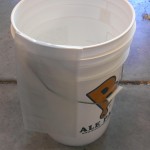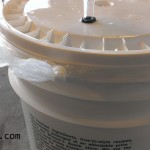Fermentation Bucket Liners
Difficulty: 
Time Required:
As long as it takes to empty the trash
Background:
So you know how much of a pain it is to clean and sanitize your carboy/bucket/conical after fermentation is complete? All that yeast residue, hop matter, etc? Well this is my method that has served me quite well the last 2 years and makes cleaning a piece of (yeast) cake.
The bags are also great to store your milled grain the night before brewday. Then re-use the bags for trash or spent grain.
When I say “bucket” in these instructions, I also mean carboy, conical, trash can, etc.
Affiliate Links
Required:
FDA Approved bag liner. See below for discussion….
Options:
Option 1 (new as of March 26, 2015)
An astute reader (see post comments) found another source on Amazon for another equivalent bag liner. I’ll pick up a case and update. They are much thinner (0.39 mil versus the 1.5 mil thick bags that I’ve been using). They are also about half the price. As of March 26, 2015, they were $26 for 250 ($0.10 / bag).
The link above is for the clear 40 gallon size, but they also have different capacities.
Fortune Plastics Hi D Tuff Folded HDPE Waste Can Liner, Star Seal
If you are an Amazon Prime member, this would be the way to go, since the cost of shipping can easily lower the cost/benefit ratio.
Here is a link to the manufacturers site and their quote about it’s food worthiness.
Hi D Tuff® liners are USDA and FDA Approved for direct food content, and implement a star seal bottom seal, the strongest, most reliable seal available utilizing pickets for wet material below the seal.
Source: http://novolex.com/products/hi-d-tuff
Option 2 (what I’ve actually used through 2014)
U-Line S-13572 Clear Trash Liners
- 24″ x 33″ bags
- 12-16 gallon
- I went way larger than the 6.5 gallon size of my buckets
- Only $2 more per box than the next size down
- I went with the heavier 1.5 mil thickness bags
- Lid seal
- Despite the thickness, the bucket lid still seals just fine
- I can even shake the fermenting bucket to oxygenate and it has never leaked
- FDA Compliant
- If you go to their website and click on “Additional Info”, it will list “FDA Compliant”
- Made from Linear Low Density Polyethylene (LDPE)
- Most fermentation buckets are made from High Density Polyethylene (HDPE)
- I called them before ordering and they couldn’t tell me what “FDA Compliant” meant
- Pre-Sanitized or sterilized?
- I don’t know
- I have always just pulled a new bag out and dropped it right in
- Never had any off flavors
- Never had any infections
- As of 11/14/13 they are $51 for 250 bags
- $0.20 / bag
- Durable
- Never had a bag leak
- fully supported by bucket anyway
- You can essentially make any container into a fermenter!
Mr. Obvious Directions:
- Pull new bag out, put into fermenter, pour in wort
- Then do everything you would normally do
- When done, rack beer as you normally would
- pull bag out, tie shut, put in trash
- easy peasy!
Directions with bonus material:
Preparation
Get the bag and bucket ready
Bag Construction
Bags are sturdy on the bottom
Easy tiger!
If you shake to oxygenate your wort, or you will be opening the lid before starting the fermentation, go directly to the next step. With the bag all the way to the bottom of the bucket, the rest of the bag COULD be pulled down all the way like this, but DON’T. I’ll get to that in a bit.
Leave a lot of the bag in the bucket
I went from shaking to oxygenate the wort, to an aquarium pump, back to shaking. Not great for my back, but this is my method for now. My point is, when you put the lid on, it does stretch the bag material and sometimes could put a hole in the bag and if you need to open the lid and reseal before starting fermentation, you may not get a good seal the next time. By leaving more bag in the bucket, after you open the lid, you can pull more fresh bag out and have a brand new seal.
Ready for the wort
My burner is at the perfect height where I just tip my kettle and pour it into the fermenter. By the time I need to lift it to pour the remaining wort, it only has about a gallon left.
Now the wort is in the bucket with the liner
If you are going to put the lid on to shake it or you need to put it in your keezer to get some extra temperature drop before pitching your yeast, go ahead and do so now.
Cut me some slack, Jack!
When you are ready to pitch your yeast and close the lid for the final time, grab the bag and pull up on it. Not enough to pull it out of the bucket, but just enough to pull the slack out of it and hopefully get rid of any potential air pockets between the bag and the walls of the bucket.
Keeping things neat and tidy
If you want, you can roll the excess bag up and then tie it into a knot.
Fermentation…..waiting……
When you are ready to rack to secondary or the keg or whatever, pop the lid and smell the awesomeness you just created.
Only the lid is messy
The lid has crud on it like usual or from the vigorous shaking you did prior to pitching the yeast.
Holes / Stretching I mentioned
See the stretching and potential holes in the bag? You only want these from the lid seal outward.
This is what’s left
Your usual yeast cake. Do notice how some sediment settles in the wrinkles of the bag. You really can’t prevent this, but it doesn’t mean you can’t have cleared beer. I’ve had some brilliantly clear beers. In my opinion, it’s all about giving it enough time to settle.
Pull the bag out
Here’s your yeast ready for washing, re-pitching, whatever
Check out that perfectly clean bucket!
And the rim is clean too
Not often, but occasionally due to the stretching of the bag or holes, I do get some beer on the lip only. Still, way easier to clean the lip than the entire bucket!
Congratulations! You just saved yourself a few minutes (if not more) of cleaning and sanitizing, plus the drying time.
February 7, 2014 Update
Ok, so even though I’ve been using the bags for over a year now, and my judgement was good enough for me, I thought I would get a second opinion.
Fortunately, it just so happened that on the Basic Brewing Radio podcast, James had recently done a couple episodes on Homebrew Toxicology.
Part 1:
Part 2:
I emailed James to get in touch with “Paul the Toxicologist” to get his opinion. Do not take this as a full endorsement from Paul or James, but just some cool homebrewers helping another homebrewer out.
Here is Paul’s response:
So on to your question about FDA compliant vs. Food Grade. There could be a difference, but it may just be semantics as well. Think “not all parallelograms are squares, but all squares are parallelograms”. FDA has a lot of regulations, so by saying it is FDA compliant does not mean it is food grade. But I would take it that if someone were to call a product food-grade, what they would mean is FDA compliant to the specific FDA regulations that deal with food contact materials.
Thank you for contacting Uline Product Questions.
In response to your question about the S-13572, 24 X 33″ 12-16 Gallon 1.5 Mil Clear Trash Liners, these bags are approved for the bagging or packaging of containers of alcoholic beverages. They are also approved for containing or packaging of non-contained beverages. Unfortunately, there is no 21 CFR reference available and no migration testing has been done on this item.
Me again:
The fact that they are approved for containing “non-contained beverages” is good enough for me. I can certainly understand the legal ramifications of the word “approved”. As a company, I am assuming that they can only list a product as approved, if the actual test has been carried out to a certain standard. The FDA standard Paul referenced does however have the caveat “excluding alcoholic beverages”.
If you listen to the Basic Brewing Radio podcasts however, you will quickly understand that when it comes to food contact, it doesn’t seem to matter what is in contact with the plastic and at normal temperatures, if something is going to leach from the plastic into your food/liquid, it is going to happen anyway. So by that logic, I work out that if it is safe for generic beverages, it is safe for alcoholic beverages.
I just wanted to say a special thanks to James Spencer of Basic Brewing Radio and Paul “the toxicologist”. I appreciate the straightforward nature of the Basic Brewing podcasts and Paul for just being a cool guy willing to help other homebrewers and to dispel some of the myths and misconceptions withing the brewing community.
For what it’s worth, Paul also found these bags. Different size, but you can work out which size you want:
Also, if you subscribe to BYO Magazine, you might have seen this in the March/April 2015 BYO Homebrew Hacks Issue. If you click on the link, you’ll be able to download a copy of the article.
















